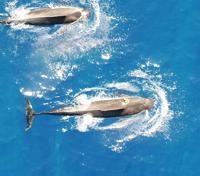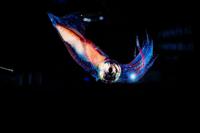Whales can eat more than 200 squid a day, reveals new research. (HIMB via SWNS)
By Stephen Beech
Whales can eat more than 200 squid a day, reveals new research.
Short-finned pilot whales consume between 82 and 202 of the marine molluscs each every day off the coast of Hawai’i, according to the study.
An international research team – made up of scientists from Australia, Denmark, Spain, and the United States – wanted to know how much squid the whales need to eat each day to survive and if there is sufficient squid to sustain the population.
They say knowing those basic facts is “essential” in the fight to protect the whales.
Their findings, published in the Journal of Experimental Biology, showed that individual Hawaiian short-finned pilot whales consume between 82 and 202 squid per day, adding up to a total of 88,000 tonnes of squid per year for the entire population.
The figure is, fortunately, “a drop in the ocean” for the local squid population, according to the research team.
They explained that how much food an animal needs to consume on a daily basis is a “crucial” part of the jigsaw of life.
A pod of Hawaiian short-finned pilot whales below the surface. (HIMB via SWNS)
The pilot whales dive to depths of up to 1,700 meters (5,580 feet) as they forage, mainly for squid.
Dr William Gough, of the University of HawaiÊ»i, said: “These animals have been studied in locations around the world, but relatively little is known about them in Hawaiian waters.”
The research team headed out into the Pacific Ocean, where they attached data-collecting tags with a detachable suction cup to eight short-finned pilot whales.
Dr. Gough said, “Short-finned pilot whales are fairly small and quick, so we really have to pick our moment.”
He explained that each tag was equipped with motion sensors, a camera with a light, hydrophones to record echolocation clicks and GPS.
Dr. Gough said, “Ideally, we attached the tag right behind the blowhole facing the head, so we could see any foraging at depth.”
The research team also hovered a drone 25 meters (82 feet) above each whale, filming so that they could figure out the animal’s size.
(Photo by Marissa Farrow via Pexels)
Retrieving the tags, which sometimes floated 50 miles in rough waters after detaching, Dr. Gough found that the whales had made 118 deep dives, going down as far as 864 meters (2,835 ft), with each whale diving approximately 39 times a day.
The researchers then analysed the whales’ tail beats as the animals descend and calculated that short-finned pilot whales use 73.8kJ/min of energy while diving and only 44.4 kJ/min when at the surface.
By listening for the tell-tale echolocation clicks on the hydrophone recordings as the whales intercepted a squid, the team estimated that the whales consume around four squid per dive and that each squid provides around 560kJ of energy when digested.
Dr. Gough then calculated that each whale must eat between 82 and 202 squid per day, totalling as many as 73,730 squid per whale per year.
Based on estimates that the whale population is made up of up to 8,000 individuals, the team calculated that the pilot whales together consume as many as 88,000 tonnes of squid each year.
Dr. Gough, who says he is “optimistic” about the future of the whales, added: “These results show that short-finned pilot whales are in relatively good shape in HawaiÊ»i, having found an abundant and reliable source of food.”





